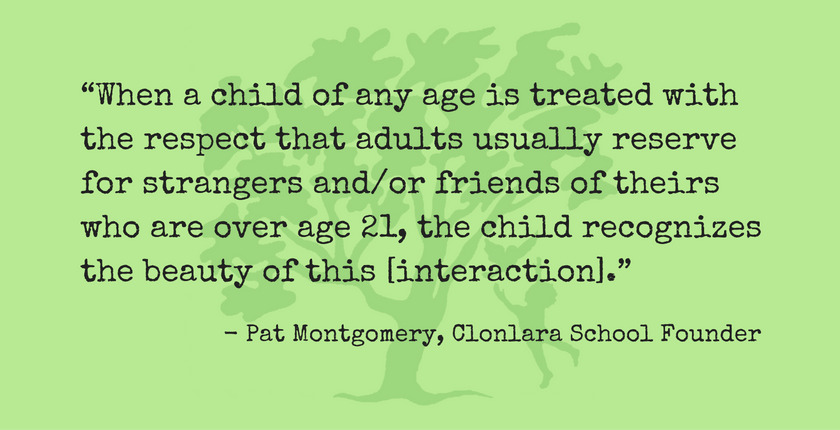By Pat Montgomery, Founder
Editor’s Note: From time to time, we’ll “look back” through our archives to share articles that are as relevant today as when they were printed. In this piece that was originally published in the April 1989 issue of The Learning Edge, Clonlara’s founder examines the dynamics of communication between adults and children.
In all of my years of interacting with students of many ages, I have been most challenged by the variety of ways that there are to communicate—adults to children.
What are the customary ways for adults to communicate with children? What is behind the choices we adults make? Do this; it’s good for you. Do that; I said so. You should (fill in the blank). How many times have I told you to (blank)?
Most of these approaches and the reasons behind them have to do with the fact that adults frequently regard children as inexperienced and in dire need of shaping, molding, training.
I was very fortunate, early on, to witness an interaction between a grandfather and his grandson. The boy, age 10, did not want to go to bed. The grandfather said, in effect, “I’m ready to have you go to bed. When do you think you’ll be ready to go?” His tone was not demanding, not preachy. He was not “pulling rank.” His question was an honest one.
The lad, I think, realized that there had to be some meeting of the minds. The grandfather was being reasonable, so he’d have to respond in kind. He negotiated with the older man. He would put his pajamas on and be all set to turn in; then, he would return to the living room for 15 more minutes of listening and chatting. The whole thing only took a minute (or less) with no fuss at all.
I started to put the lesson into practice. What I learned along the way often contributed more to my self-knowledge and personal growth than to that of the youngster I was addressing. I was forced to examine my own motives: Why did I expect to be obeyed immediately upon giving an order? Why was it so vital to me to be listened to so attentively that a child couldn’t even be playing with a ruler or pencil as I spoke? Why did my opinion about things (written work, the cleanliness of a room, say) matter more than his/hers? Why were the “rules” that I established for the classroom and the home so inviolable? On which matters did I need to be totally inflexible? I recommend these questions to all!
The answers to these questions surprised me time and time again. Mostly, it boils down to the need for me to be unbending only when an issue of safety is involved. Interestingly enough, the issue of safety arises very, very seldom. More often for little tots than for older youngsters.
Other parents and teachers wonder aloud to me: If an adult doesn’t show that s/he means business (gives orders, snaps, etc.), a child will “take advantage” or otherwise lose respect for authority. This has never been my experience. In fact, the opposite is true. When a child of any age is treated with the respect that adults usually reserve for strangers and/or friends of theirs who are over age 21, the child recognizes the beauty of this. His/her response is as logical as that of the pajama-clad boy respecting his granddad’s “rule.”
Do you have any advice or reflections to share about communicating with students of different ages? Please add your comments below.








2 Responses
Not one child is identical to another. Accept them as individuals, teach them to be creative thinkers, learn from them and respect them. They are like kites. Sometimes there may be some tangles that get in the way, but when they are taught to be creative thinkers, they become creative learners who are not afraid to fly. Teachers and families that model this behavior will have the joy of seeing many kites flying high in the sky.
– Cathy Thorne, Youngers Teacher (Grades K-5)
A child can be less ready to decide to go promptly to bed under his grandfather’s non-order or tender suggestion for appreciating immensely his divine ancestor inspiring his sunsets by the sea beyond his- their own death: It will depend on the grandfather and on the grandson to be both distinguished individuals what means, I am afraid but I am certainly wrong, they were both educated in common sense rules (to be clean, to be kind, to be silent enough to attentively listen to silence etc, not to eat during the lessons, and a few more…) to allow gradually themselves to transgress rules which artistically bourgeois and simply elegant as it is recognized among elegant persons. But in a general way how to spread elegance to society for those who are urgently in need of it and more (bread and employment, for instance) and do not have wise ancestors and do not own quietness of spirit to be aware of readyness?
Still a teacher, selective, selected, …would have to read children and determine what each one deserves in a precise moment to be sliding for more, for less of flexibility and freedom? There are students who are already polished in freedom, born in creativity and politeness: I adapt to them in smiling and generosity. I may be a Rottweiler to those who try apparent success, dishonest laziness and those are my great lifelong friends for having been tortured by my fight to polish them this rough passionate way. What does a school do with lazy grandparents’ granddaughters to be comfortable in our classroom? Should we primarily educate their ancestors before august in an intensive course? Discipline is melody to be solemnely listened to and it is elastic from the inside out. From the outside, with no soul, it is just an ineffective army to be defeated.